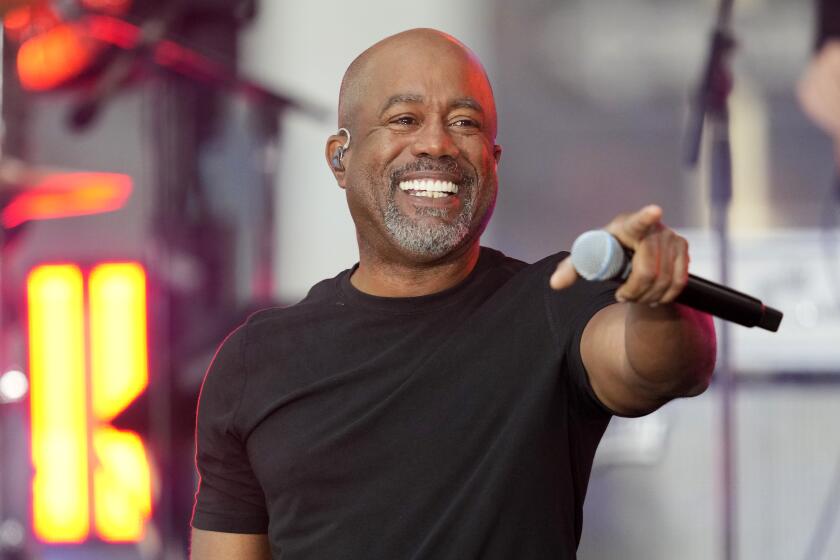Disney’s Iger Explores Ratings Frontierland
Should there be one rating system for movies, television, music and video games?
Are some popular proposals to limit the exposure of children to “inappropriate” material less than they seem?
Can Hollywood be expected to speak with one voice on such matters?
These were among the issues left hanging this week after leaders of the major Hollywood studios were called before the Senate Commerce Committee after the release of a Federal Trade Commission report showing how R-rated films were being marketed to--and tested before--children who were not supposed to be their audience. While the Motion Picture Assn. of America announced 12 voluntary guidelines--such as not previewing R-rated films at showings of G-rated ones--several studios promised to go further, by refusing to show such trailers to audiences seeing PG-rated movies, for instance. But none went so far as the Walt Disney Co., which unveiled a six-point plan including a pledge to carry no ads for R-rated films before 9 p.m. on its ABC television network.
It also was Disney President Robert Iger who revived the idea of a single rating system for everything from TV sitcoms to CDs and video games. He suggested the MPAA’s own well-known system for films--G, PG, PG-13, R and NC-17.
Iger discussed that proposal--and the related controversies--after he had returned from the cross-examination before a not-always-friendly congressional panel.
*
Question: Why did you suggest the single rating system at this time?
Answer: Largely because we believe that those you would really want to use a rating system most--parents--are faced with way too much choice, and too much variety, in the systems used across media platforms. The newer ones--the television system, for instance--have not been around long enough to really have achieved a level of understanding, for the population at large to be educated about them.
I have been associated with the television system since it was created. I was involved in its creation and implementation when I was at ABC. And if you would ask me today to name every single ratings category, I could probably do so, but I would struggle to come up with them. And I’m a supposed expert. Now imagine how families or parents are viewing it.
The bottom line is, I think there’s a tremendous amount of confusion out there. We believe the universal rating system should be the MPAA system, or if need be a very slight variety of that.
We all--meaning on the creative side--seem to agree that the government shouldn’t be playing a role in this, that this should be voluntary. However, we’ve all bought into the notion that parents do need the tools to make these decisions. Let’s give them an effective tool, let’s simplify it for them.
Q: As a practical matter, though, it’s hard to imagine how ratings panels would evaluate the huge amount of music that comes out in the same way they do movies now.
A: The same would apply to television. I’m not denying there are practical issues here. The application of a universal system in some aspects could be impractical. But I don’t believe we ought to let these barriers get in the way of our at least exploring this. Those that are opposing it just categorically rejected the idea. Not only isn’t that helpful, it’s way too premature to do that.
I agree that the sheer volume of content produced by the music industry or the television industry would make it difficult to apply one system. The MPAA’s system and the ratings that come out of it are determined by an independent group of parents. They rate a product that, when compared with television and music, is fairly finite and manageable in size and scope.
In the current television ratings, the television industry rates its own programs. That gives them a great deal of freedom in a way. I’m not in any way criticizing the manner in which the ratings have been applied. The industry has been appropriately responsible in the ratings of its shows. The problem is, the system that we created is dense and confusing. I hate to be this strong, but I might as well--I think it’s been a failure.
Q: You’ve gotten other criticisms . . .
A: The V-chip is another. [Critics say] that there’s already an embedded base of television sets with the V-chip. And they would be rendered, I guess, impotent if you changed the system. There, too, I think we’re too dismissive of the concept. OK, so there’s an issue. Let’s sit down and try to determine, “Is it a hurdle we can jump over?”
Q: We’ve already noted in print that some of the other studios were irked that you folks at Disney were so quick in releasing your own plan, taking this preemptive strike before Congress got to you, perhaps trying to make it look like you were on the side of the angels.
A: There was some criticism communicated through our Washington office. But in fairness, they were given every opportunity in the world to be with us when we announced our guidelines. We telegraphed to them we were doing it, we participated in lengthy dialogue with them about not only what our guidelines would be, but that they were coming.
But there was such disagreement as to . . . what the guidelines should be. They were negotiating to an extreme about language, specific words for each guideline. We had a hard enough time, by the way, as one company, doing it. So to some extent I’m sympathetic. We spent countless hours on this. I was involved. Michael Eisner was involved. Essentially the senior management of the entire company got involved in the creation of the guidelines for the Walt Disney Co. So when you put eight companies around one table, and you try to create guidelines that work for everyone, that’s no easy task.
Actually, what the MPAA and Jack Valenti accomplished was Herculean, to get them all together. But we weren’t grandstanding, we weren’t trying to upstage them. We were ahead of the game both in terms trying to create guidelines and our sense for what they should be.
Q: What sort of mundane issues were tough to work out in your internal debates?
A: If you create guidelines, how many different directions can or should they be applied? You start talking about being responsible in terms of your marketing, not inappropriately targeting kids under 17. We were focused initially on things like television, but then someone raised teen magazines or Web sites or billboards. Before we knew it, this thing was mushrooming.
We finally decided that we were never going to think of everything. Therefore, let’s admit that this is not static. This is something that’s going to have to be under constant review.
Q: It is complicated when you get to teen magazines, say. If you have a film with a star who’s a kid, you stand a good chance of getting publicity in them, don’t you?
A: Let’s just say, “Sixth Sense.” I think that was probably PG-13, so that’s not a good example, but obviously there was a child actor. If he suddenly was pictured through the editorial process in a magazine, basically for a movie that wouldn’t be deemed appropriate for a number of readers of that magazine, I don’t think that’s a responsibility we would take. But if we took an ad in that magazine for the movie, that would be a different story.
Q: Another complicated issue is the 35% criteria some have suggested--that you should not advertise R-rated movies on TV programs that draw more than 35% of their audience from ages under 17. You suggested that’s not enough and used your most popular show, “Who Wants to Be a Millionaire” as an example.
A: Right. The 35% threshold was actually first mentioned by FTC Chairman [Robert] Pitofsky. So we said, ‘OK, let’s take a look at what would happen were we to do that.’ So we looked at all our programs that had an audience makeup 35% or higher of kids under 17. There weren’t many. ‘Millionaire’ was not one of them. So that would mean, had we adopted that rule, we could have run ads for R-rated films in ‘Millionaire.’ But then we realized that the 10% to 11% [of the show] audience [that is] under 17 actually was greater in terms of total number of kids watching that show than most of the programs on television whose audience makeup is 35% kids 2 to 17.
The companies that adopted the 35% should take note of that. We’re not going to take ads for R-rated films on ‘Millionaire’ when it airs as an 8 o’clock program. There are too many kids watching it . . . countless millions of kids. . . .
Q: Though you studio executives were the ones put in the spotlight this time, it seems like the strongest complaints target music.
A: Maybe it’s the nature of that content, I don’t know. I do get the sense that they may be facing a level of criticism or scrutiny that’s seems to be even greater than the movie or the television industry. Video games seem to be targeted as well. We’re very comfortable with the position we stalked out [Wednesday] and believe it would be precipitous of anyone to simply dismiss the notion of a universal system. Look, I think we would go a long way if we could just create a system that applied to television and the movies. If we could create one that applied to music and video games that would be even better. We don’t want to give up on the notion.
Q: Even as most of the studios keep agreeing to further self-regulation, you fellows were portrayed almost like those tobacco CEOs who were called before Congress a few years back.
A: I heard that. I thought it was patently ridiculous. I certainly don’t think that the issues involved here were in any way analogous to the issues in the tobacco industry.
It’s interesting because I sat there as one of eight, but in reality, I was representing the Walt Disney Co. It really wasn’t part of an industry-wide strategy, or an industry-wide movement.
More to Read
The biggest entertainment stories
Get our big stories about Hollywood, film, television, music, arts, culture and more right in your inbox as soon as they publish.
You may occasionally receive promotional content from the Los Angeles Times.










